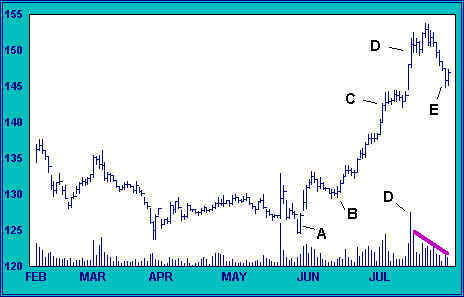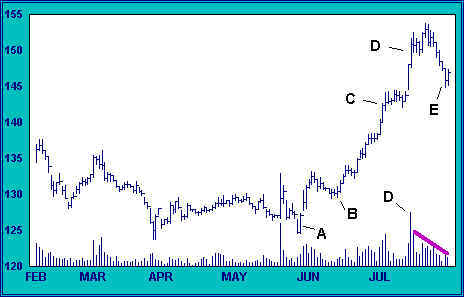Passive Selling
After our purchases at A and again at B, the index rallies strongly over the following two months. At C,the rally accelerates on widening spread and increased volume.This set of conditions is characteristic of the markup stage and may be generally interpreted as bullish. Nevertheless, the index has rallied to our first objective of 143, so we are on guard for signs of distribution.
On the session following C, the high-low spread narrows and volume increases; there is no net advance on the day. This evidence of supply has our attention. Over the next few sessions volume dries up as the price marks time.We conclude that supply is being absorbed successfully and that the next objective around 152 is likely.
The price rallies abruptly from the congestion zone at C, followed by another rally session to D on very high volume. The price has now risen to our second objective (152), and we are again watchful for signs of distribution.
So far we have witnessed generally increasing volume during rallies with decreasing volume during price recessions. This pattern of price-volume behavior is typical of bullish advances. We know, however, that since shares are distributed during rising markets, distribution by strong hands appears similar to other, more bullish phases of markup.
What alerts us now are the price-volume extremes of recent sessions. The hyperbolic rally to D is just the sort of advertisement which attracts the majority of traders, who are unwilling to risk a position until the market’s strength is clearly evident.
Volume tells the rest of the story. Volume can be viewed, in one of its many facets, as effort.On the session just after the rally to D, extremely high volume (effort) is unable to produce any further price improvement (result). The rapid advance has drawn a crowd, and we conclude that strong hands are using the opportunity to unload.
The index has reached the second of three objectives, and evidence that strong hands are beginning to distribute into strength has appeared. While there remains the possibility of a still higher objective, we decide to adjust the size of our position to reflect shifting odds. We sell part of our position at the market.
The index corrects to E on declining volume. Sellers are not yet aggressive; they are not pursuing the price down with heavy sell orders but are for now content to sell only on strength. The lack of volume on the decline indicates that sellers remain passive, that they will likely wait for another wave of buying before resuming distribution in size. It takes time to distribute large positions, and strong hands dare not dampen the public’s enthusiasm for equities too soon, before they have distributed the largest part of their line.
We maintain our trimmed-down long position. The trend is still up, and despite initial signs of distribution, the index may yet rally to the neighborhood of our third target of 158. On the other hand, should we become convinced that sellers are turning aggressive, we are prepared to exit our remaining position at the market.




Join the discussion